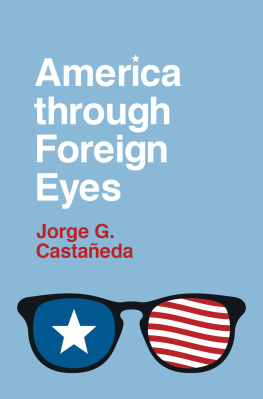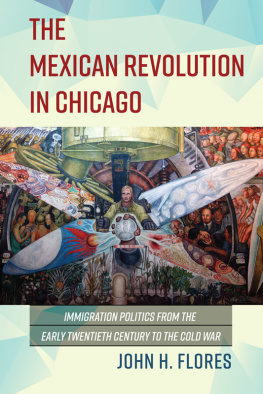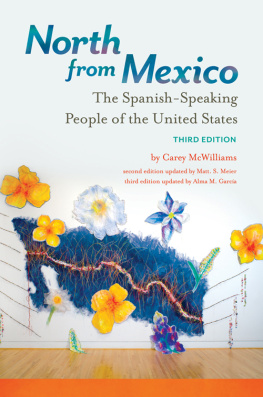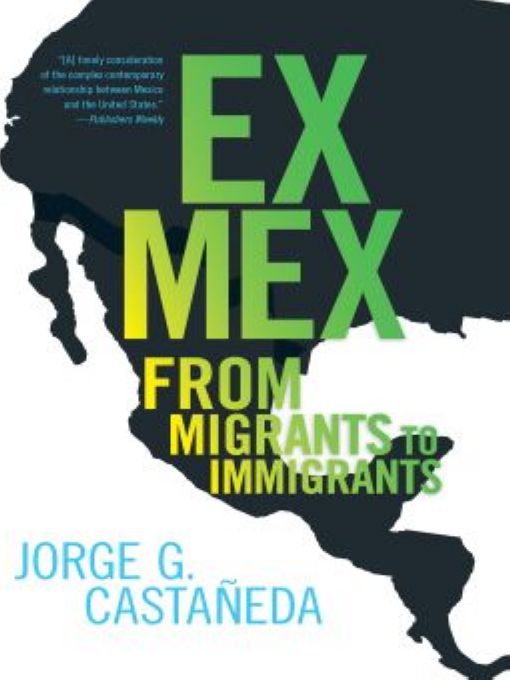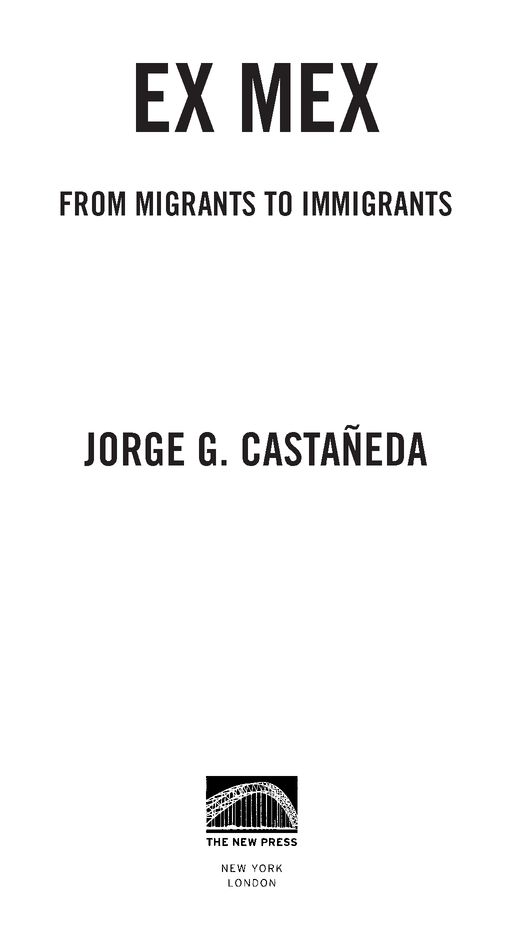Table of Contents
ALSO BY JORGE G. CASTAEDA FROM THE NEW PRESS
Perpetuating Power
The Mexican Shock
This book is dedicated to the hundreds of Mexican consular officials scattered across the United States whom I had the honor of working with and leading during my tenure as foreign minister, and who selflessly and proudly do their very best, under highly adverse circumstances, to protect and defend our countrymen abroad.
PREFACE
Before anything else, a few words are in order... about what this book is not. I decided against attempting to produce a scholarly treatise on immigration in general, or on Mexican migration to the United States in particular and in recent times. There are far more qualified and prolific academics than I capable of doing so on both sides of the border, and they have done so, over the years. Among them, from different eras, scholars such as Jorge Bustamante (the dean of Mexican migrationists), Agustin Escobar, Jorge Durand (actually of Peruvian origin), Victor Zuiga and Ruben Hernndez-Len, and others from Mexico, together with Wayne Cornelius, Frank Bean, Douglas Massey, Demetri Papademetriou and Frank Sharry, Jeffrey Passell, Alejandro Portes, Manuel Garca y Griego, Roberto Suro, and their colleagues in the United States, have done this far better than I could ever hope to. I have tried to benefit from their research, their expertise, and their conclusions, accurately or not, faithfully or not; without their work, this effort would be impossible, but it does not seek to add a great deal of academic knowledge to what they have accomplished, and will continue to achieve.
Concepts such as dispersion or diffusion, circularity and its interruption, quantitative changes becoming qualitative ones, continuity and contiguity, and further theoretical notions mentioned throughout these pages are, needless to say, not of my manufacture. If anything, I simply updated and placed them in a political and binational context. Herein lies the explanation for the virtual absence of footnotes or in-page citations, although every book, essay, article, document, or interviewwhen possible including an electronic addressis cited in a bibliographical appendix. Whoever wants to know more, or would like to corroborate a fact, statement, or opinion, can do so, while those who just wish to read more comfortably will not be perturbed by the inevitably cumbersome habit of citations, dates, publishers, or references on the page or elsewhere. This is a book for the layman, though I hope the expert will find in it something of use, and, more important, no major misconceptions.
Second, this is not an extended policy paper: what to do, or not to do, in addressing the challenge of migration from Mexico to the United States, and the multiple dilemmas it has wrought for both countries. That is the purpose of the various task-force reportsMexican, American, and binational, as well as the work of experts and friends such as Frank Sharry, Tamar Jacoby, and Demetri Papademetriouquoted extensively in this text. They all enjoyed the benefit of resources, pluralism, and versatility that no individual can hope to match; I have only tried to build on the foundations they laid over the past decade or more. Nor is this a journalistic accountanecdotes, vignettes, etc.of immigration today. Given the currency of the issue in these times, and the reporting talent available in both countries, it would be foolhardy for anyone alien to the profession to dare to intrude on it in this fashion: the reporters and correspondents work is quoted and referred to in this book, but the latter is not an effort to rival or replace it. Furthermore, this book does not seek to describe or analyze two of the most recent trends in Mexican migration to the United States: the growing exodus of middle-class professionals from Mexicodoctors, dentists, lawyers, accountants, architects, traders, and executivesto many areas in the United States, from Manhattan to the Twin Cities; and the talent drain, that has led stars from Alejandro Gonzlez Iarritu to Salma Hayek, from Alfonso Cuarn to Enrique Norten, from Mario Molina to the late Eduardo Mata, to settle down at least half-time in the United States, where their success is perhaps less difficult to carry than back home. Finally, this is not a memoir by a policy-maker or public figure. I sincerely do not believe my time in office as Mexicos foreign minister, nor what I accomplished in this particular field during my tenure, merits such a title or, indeed, an endeavor of that nature.
Nonetheless, this book does seek to be, partly and modestly, all of the above. Its aim is to provide the reader with an accurate, readable, current, well-informed, and solidly grounded, though fundamentally single-sided, basis for understanding one of the most crucial, controversial, and complex issues in the United States and Mexico today. Single-sidedand I deliberately omit the term one-sidedbecause it is written from a Mexican perspective, but, unlike many of my previous publishing efforts, at least initially, and in all likelihood exclusively, for a U.S. audience. That is where the debate is raging. In Mexico there is not much disagreement anymore on migration; if anything, as we shall see, there are disputes over details, consequences, tactics, and strategynot more. But in the course of the vigorousand on occasion viciousdebate north of the border, it seems to me that the Mexican viewpoint is not always present in the mainstream U.S. discourse. Either because Mexicans in the United Statesby definition, the most interested partydo not have access to the ways and means necessary to get their point of view across; or because the Mexican government, after my departure, decided to tone down its decibel level; or because U.S. sympathizers, interpreters, or students of this perspective, regardless of their passion for or affinity with Mexico, inevitably adapt themselves to the context they are immersed in: at the end of the day, it is an American debate. Thus, while this book hopes to be appropriately researcheddrawing on the wisdom of the experts and policy-directedusing the encounters and documents I enjoyed the privilege of having access to as a Mexican government official; accessible and descriptiveavailing itself of straightforward narrative resources and based upon personal experienceI have been following the migration question in one way or another now for nearly two decadesit should be seen mainly as one more Mexican contribution to the U.S. discussion: not, with false modesty, as an incidental one and certainly not, immodestly, as a definitive one.
Why Mexico? Why immigration? Why now? The three questions are obviously linked, and produce relatively obvious answers. For all practical purposes, the debate in the United States regarding immigration refers to illegal, or unauthorized or undocumented, migrationas we shall see, the terminology is everything but a minor or irrelevant themeand much less so to the traditional, officially permitted or lawful flows of people from all over the world, frequently well-qualified and educated, and almost always welcomed by a majority of Americans. And unlawful migration is, above all, today, perhaps as it has been now for more than a century, overwhelmingly Mexican. By all accounts, whether one is estimating the flow or the stock, todays numbers or yesterdays, conservative projections or doomsday scenarios, between half and two-thirds of any figure one chooses is Mexican. There are roughly 12 million unauthorized non-American-born individuals currently in the United States; at least 6 million are Mexican; every year around half a million people enter the United States without papers; at least 350,000 to 400,000 are Mexican. And a similar proportion emerges from the legal numbers, or from the historic ones: Latino or Hispanic heritage in the United States means, more than ever, Mexican. The flow of Cubans, Puerto Ricans, and Central Americans is drying up, and other Latin Americans, for now at least, cannot match the Mexican exception.


